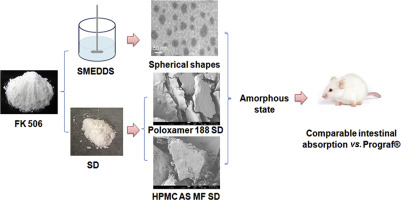Abstract
This study aimed to compare the dissolution and the intestinal absorption of tacrolimus in self-microemulsifying drug delivery system (SMEDDS) and solid dispersion (SD). Poloxamer 188 SD was prepared by the combination of the solvent evaporation method and the freeze drying method. Hydroxypropyl methylcellulose (HPMC) SD was prepared by the solvent evaporation method combined with the vacuum drying method. The formation of SD was confirmed by SEM images which showed new solid phases. The SMEDDS was composed of oil (Labrafil M1944 CS 28%), surfactant (Cremophor EL 48%) and co-surfactant (Transcutol P 24%). The self microemulsion formed by the SMEDDS upon aqueous media had spherical droplets with a hydrodynamic size of 46.0 ± 3.2 nm. The dissolution of tacrolimus from SD and SMEDDS was performed in sink and non-sink conditions with various pH. As revealed by the DSC and FT-IR, the tacrolimus was molecularly or amorphously dispersed in the SMEDDS and SD. The in vivo intestinal absorption study in rats showed that both SMEDDS and SD improved the absorption of tacrolimus over the raw tacrolimus while the SMEDDS exhibited lower absorption rate constant (Ka) and apparent permeability coefficients (Papp) than the SD. The self-prepared SD with poloxamer 188 or HPMC had comparable intestinal absorption as compared with Prograf®. The tacrolimus-loaded SMEDDS and SD would be further compared by in vivo pharmacokinetic study.

